Dell S3222HN MonitorDell Display Manager User’s GuideModel: S3222HN Regulatory model: S3222HNc
NOTE: A NOTE indicates important information that helps you make better use of your computer.
CAUTION: A CAUTION indicates potential damage to hardware or loss of data if instructions are not followed.
WARNING: A WARNING indicates a potential for property damage, personal injury, or death.
Copyright © 2021 Dell Inc. or its subsidiaries. All rights reserved. Dell, EMC, and other trademarks are trademarks of Dell Inc. or its subsidiaries. Other trademarks may be trademarks of their respectiveowners.2021 – 08 Rev. A00
Overview
Dell Display Manager is an application that allows users to configure their supported Dell monitor settings such as brightness, contrast, and preset modes. After its installation, Dell Display Manager is accessible from the notification tray. Informationabout monitors connected to the system is available when the mouse is hovered over the notification tray icon.
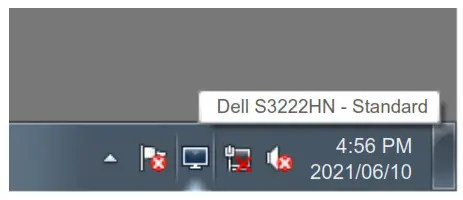
NOTE: Dell Display Manager uses Display Data Channel Command Interface (DDC/CI) channel to communicate with your monitor. Ensure that DDC/CI is enabled in the menu as follows:
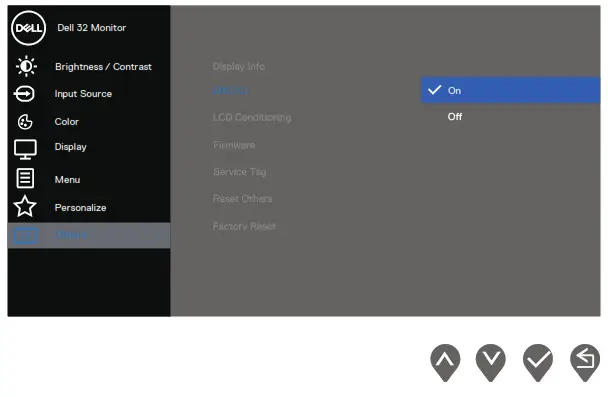
Selecting Quick Settings options
Clicking Dell Display Manager’s notification tray opens the Quick Settings window. If more than one supported Dell monitor is connected to the system, a specific target monitor can be selected from the Display drop-down list.In the Quick Settings window, you can also change the following:* Resolution* Auto Mode or Manual Mode the screen appearance* Brightness and contrast levels* Easy Arrange window layouts for the monitor
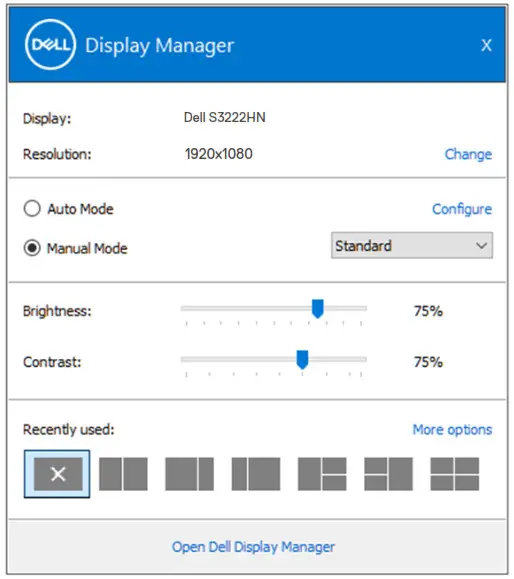
In the Quick Settings window, you can also click Open Dell Display Managermore advanced settings.Selecting Quick Settings options
NOTE:
| Feature | Function | Description |
| Quick DDM Access | Quick key to call up DDM UI. | Ctrl+Shift+D |
| Control individual monitor in a multi-monitor setup | From dropdown box to select monitor, the selected monitor has Dell logo shown. Move DDM UI to the monitor to becontrolled. Press Ctrl+Shift+D to bring up the mini UI under the mouse pointer.
|
Setting basic display options
You can select Manual Mode to manually select a preset mode or select Auto Mode that applies a preset mode based on the active application. An on-screen message displays the current preset mode whenever it changes. The selected monitor’s brightness and contrast levels can also be directly adjusted from the Basic tab.

NOTE: When multiple Dell monitors are connected, select “Enable display matrix control” to apply brightness, contrast, and color preset controls to all monitors.
![]()
Assigning preset modes to applications
The Auto Mode tab enables you to associate a specific Preset Mode with a specific application, and apply it automatically. When Auto Mode is enabled, Dell Display Manager will automatically switch to the corresponding Preset Mode whenever the associated application is activated. The Preset Mode assigned to a particular application may be the same on each connected monitor, or it can vary from one monitor to the next. Dell Display Manager is pre-configured for many popular applications. To add a new application to the assignment list, simply drag the application from the desktop, Windows Start Menu, or elsewhere, and drop it onto the current list.NOTE: Preset Mode assignments for batch files, scripts, loaders, and non-executable files such as zip archives or packed files, are not supported.You can also configure the Game preset mode to be used whenever a Direct3D application runs in full-screen mode. To prevent an application from user mode, assign a different preset mode to it.
![]()
Organizing windows with Easy Arrange
On supported Dell monitors, the Easy Arrange tab enables you to easily arrange the open windows in one of the predefined layouts by dragging them in the zones. Press “>” or use the Page Up/Page Down key to find more layouts. To create a custom layout, arrange the open windows and then click Save. To get started with Easy Arrange, choose a target monitor and select one of the predefined layouts. The regions for that layout are displayed momentarily on the monitor. Next, drag an open window across the monitor. While the window is being dragged, the current window layout is displayed and an active region gets highlighted as the window passes over it. At any time, drop the window into the active region to place the window in that region.
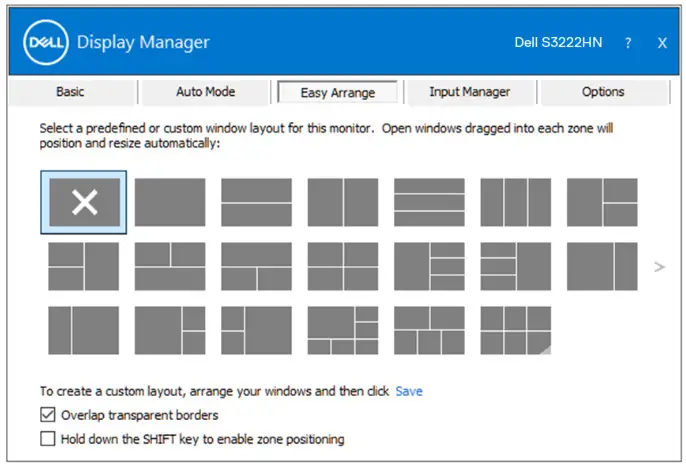
To create a custom window layout, size and position the windows on the desktop and then click the Save link in Easy Arrange. The size and position of the windows is saved as a custom layout and the custom layout icon is created.NOTE: This option does not save or remember the applications that are open. Only the size and position of the windows is saved.
Organizing windows with Easy Arrange

To use the custom layout, select the custom layout icon. To delete the currently saved custom layout, close all windows on the desktop and then click the Save link in Easy Arrange.

| Feature | Function | Description |
| Enhanced Easy Arrange | Custom layouts | Save and name 5 customized Easy Arrange patterns.
Configure ey patterns. |
| 6 MRU (most-recently-used) layouts | Press Ctrl+Shift+Home to cycle among the last 6 MRU layouts. | |
| On the fly partition resizing | Hold down Ctrl while resizing current Easy Arrange layout to adjust the size and numbers of cells in a layout.
Newly formed Easy Arrange pattern is saved into the Easy Arrange icon position. Hold down Ctrl while clicking on a modified layout icon to restore it to default layout. |
|
| Easy Arrange layouts for portrait mode | Portrait mode Easy Arrange icons are presented when monitor is rotated. |
NOTE: An application may require a minimum effective resolution for its application window. Such application may not fit in an Ease Arrange zone if the zone is smaller than the required window size.
Managing Multiple Video Inputs
The Input Manager tab enables you to manage multiple video inputs connected to your Dell monitor. It makes it very easy to switch between inputs while you work with multiple computers. All video input ports available to your monitor are listed. You can give each input a name as you like. Please save your changes after editing. You can define a shortcut key to quickly switch to your favorite input and another shortcut key to quickly switch between two inputs if you often work between them.
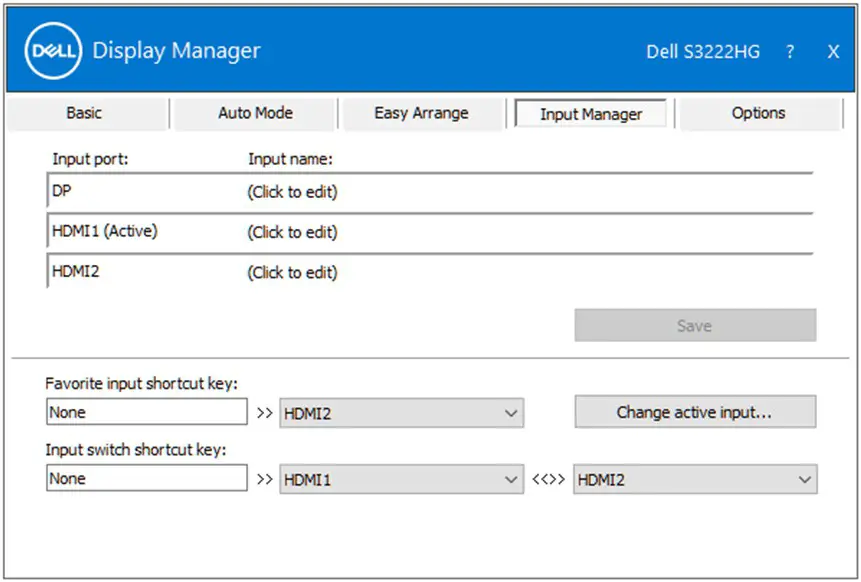
NOTE: Dell Display Manager (DDM) communicates with your monitor even when the monitor is displaying video from another computer. You can install Dell Display Manager on the computer you frequently use and control input switching from it. You may also install Dell Display Manager on other computers connected to the monitor.
Restoring Application Positions
Dell Display Manager can help you restore application windows into their positions when you reconnect your computer to the monitor(s). You can quickly access this feature by right-clicking on the Dell Display Manager icon in the notification tray.
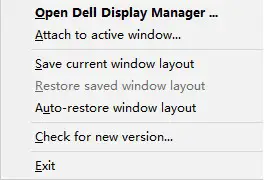
If you choose “Auto-restore window layout”, your application windows’ positions are tracked and remembered by Dell Display Manager. Dell Display Manager automatically puts the application windows into their original positions when you reconnect your computer to your monitor(s).

Restoring Application Positions
If you want to go back to a favorite layout after you have moved the application windows around, you can first “Save current window layout” and later “Restore saved window layout”.
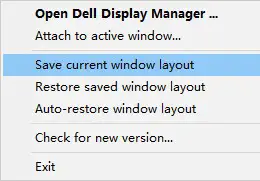
You may use monitors with different models or resolutions in your daily routine, and you may apply different window layouts on them. Dell Display Manager is able to know the monitor you have reconnected and restore application positions accordingly. In case you need to replace a monitor in a monitor matrix configuration, you can save the window layout before replacement and restore the layout after a new monitor is installed.NOTE: You should keep your applications running in order to benefit from this feature. Dell Display Manager does not launch applications.
Attach DDM to the active window (Windows 10 only)
DDM icon can be attached to the active window you are working on. Click on the icon for easy access to the following features.
| Feature | .
Function |
.
Description |
| Attach DDM to Active Window (Windows 10 only) | Change preset or snap to different partitions | DDM icon attached to active window and user can easily switch window position, change color preset mode, and associate auto preset mode. |
| Shortcut key trigger | On a running app window, pressing Ctrl+Shift+Ins also triggers the attached DDM menu. | |
| Move app window among Easy Arrange cells | Send the app window to the previous/next Easy Arrange cell. | |
| Move app window a among monitors | Send the app window to the previous/next monitor. |
![]()
Attach Ddm to the active window (Windows 10 only)
Setting energy conservation options
On supported Dell monitor models, an Options tab is available for selecting PowerNap energy conservation options. You can set the monitor’s brightness to the minimum level or to put the monitor to sleep when the screensaver is activated.
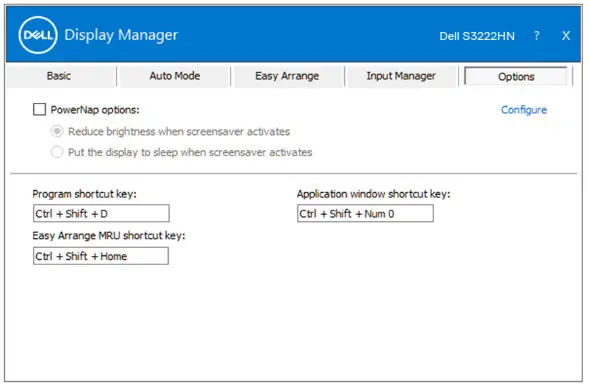
Setting energy conservation options
Other Shortcut Keys
Shortcut keys can be defined for the following operations:
- Program shortcut key: to quickly open the Quick Settings dialog box.
- Easy Arrange MRU shortcut key: to quickly apply the 5 recently used window layouts.
- Application window shortcut key: to launch a quick menu for options under Auto Mode and Easy Arrange.

Other Shortcut Keys
Troubleshooting
DDM only works with supported Dell monitors. DDM does not support monitors from other manufacturers. If DDM cannot work with your monitor, DDM will show the following icon in your notification tray.
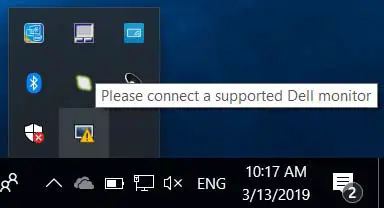
When the icon is clicked, DDM shows a more detailed error message.

If DDM is unable to detect and/or communicate with a supported Dell monitor, try the following troubleshooting steps:
- Ensure the video cable is properly connected to your monitor and yourcomputer. The connectors should be firmly inserted into position.
- Check the monitor OSD to ensure DDC/CI is enabled.
- Ensure you have the correct and latest graphics card driver from your graphic card manufacturers such as Intel, AMD, and NVIDIA. Incompatible or old version of the graphics card driver causes DDM to fail.
- Remove any docking stations or cable extenders or converters between the monitor and the graphics port. Some low-cost extenders, hubs, or converters may not support DDC/CI properly and may cause the DDM application to fail.Update the driver of such a device if the latest version is available.
- Restart your computer. DDM may not work on the following monitors:• Dell monitor models from 2013 or earlier and D-series of Dell monitors. You canrefer to Dell Product Support websites for more information.• Gaming monitors using Nvidia-based G-sync technology.• Virtual and wireless displays do not support DDC/CI.• On older models of monitors with DisplayPort version 1.2, you may need todisable MST/DP 1.2 using the OSD menu on the monitor.
If your computer is connected to the Internet, you will be prompted with a message when a newer version of DDM application is available. It is recommended to download and install the latest DDM application. You may also check for a new version by right-clicking on DDM icon while pressing and holding the Shift key.
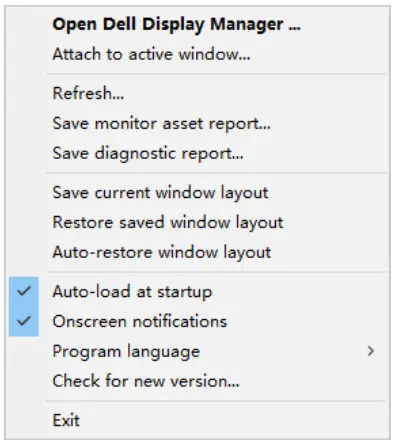
 Troubleshooting
Troubleshooting
[xyz-ips snippet=”download-snippet”]
